初一英语时态专题复习
七年级英语七年级下册时态复习

七年级英语七年级下册时态复习在七年级英语下册的学习中,时态是非常重要的语法知识点。
掌握好时态,对于我们准确地表达思想、理解英语语言有着至关重要的作用。
接下来,让我们一起对七年级下册所学的时态进行一次全面的复习。
一、一般现在时一般现在时表示经常发生的动作或存在的状态。
当主语是第三人称单数时,动词要发生相应的变化。
比如,“He plays football every day” 中的“plays”就是动词“play”的第三人称单数形式。
一般现在时的构成:1、主语+ be(am/is/are)+表语I am a studentThey are happy2、主语+实义动词(注意第三人称单数形式)We study hardShe likes music常与一般现在时连用的时间状语有:always, usually, often, sometimes, never, every day/week/month/year 等。
二、现在进行时现在进行时表示正在进行的动作。
其构成是“主语+be(am/is/are)+现在分词”。
例如,“I am reading a book now”现在分词的构成规则:1、一般情况下,直接在动词后加 ing,如:read reading。
2、以不发音的 e 结尾的动词,去掉 e 再加 ing,如:write writing。
3、以重读闭音节结尾,且末尾只有一个辅音字母的动词,双写这个辅音字母再加 ing,如:run running。
常与现在进行时连用的时间状语有:now, at the moment, look, listen 等。
三、一般过去时一般过去时表示过去发生的动作或存在的状态。
其构成有两种:1、主语+ was/were +表语I was at home yesterdayThey were late for school2、主语+动词的过去式She played the piano last nightWe went to the zoo last week动词过去式的构成规则有很多,常见的有:1、一般在动词后加 ed,如:work worked。
初中英语六种时态复习课件(35张PPT)

②while 引导的从句表示“在……期间”,主从句谓语动词所表示的动 作同时ቤተ መጻሕፍቲ ባይዱ生。这时,主从句都用过去进行时。
e.g.:My father was reading the newspaper while my mother was watching TV.当我的妈妈看电视的时候,我的爸爸正在看报纸。
(2)表示普遍真理或客观事实。 e.g.:The sun rises in the east.太阳从东方升起。 (3)在条件状语从句和时间状语从句中,用一般现在时表示将来。 e.g.:If it doesn't rain tomorrow,we will go for a picnic.如果明天不下 雨,我们将去野餐。 (4)在某些以 here,there 开头的句子中用一般现在时表示正在发生的动作。 e.g.:There goes the bell.铃响了。
(3)现在进行时表示将来 表示位置移动的动词 go,come,leave,fly,start,meet,move 等, 可以用现在进行时表示将要发生的事。 e.g.:We are leaving for London.我们就要动身去伦敦了。
(4)一般现在时表示将来 ①表示按规定或时间表预计要发生的动作。 e.g.:Our plane takes off at 8:10.我们的飞机 8:10 起飞。 ②当主句为一般将来时,或含有情态动词,或是祈使句时,在 if,as soon as,until,when 等引导的状语从句中用一般现在时表示将来。 e.g.:I will give him the book as soon as he comes here.他一来这儿, 我就把这本书给他。
(2)表示当前一段时间内的活动或现阶段正在进行的动作。 e.g.:They are picking apples on a farm all the time.他们一直在农场 摘苹果。 (3)与 always,usually 等词连用,表达说话人强烈的感情,如赞扬、不 满、讨厌等。 e.g.:Mary is always thinking of others instead of herself.玛丽总是为 别人着想,而不为自己着想。
初中英语8种时态复习及专题练习

初中英语8种时态复习I.时态详解一、一般现在时:概念:①表现在存在的状态;②现在经常、反复发生的动作。
时间状语:always,usually,often,sometimes,everyweek(day,year,month…),onceaweek,onSund ays,etc.基本结构:①主语+be(am,is,are);②主语+行为动词原型(单三形式主语+动词单三形式)否定形式:①am/is/are+not;(is+not=isn’t;are+not=aren’t)②此时态的谓语动词若为行为动词,则在其前加don't,如主语为第三人称单数,则用doesn't,同时还原行为动词。
一般疑问句:①把be动词放于句首;②用助动词do提问,如主语为第三人称单数,则用does,同时,还原行为动词。
二、一般过去时:概念:①过去某个时间里发生的动作或状态;②过去习惯性、经常性的动作、行为。
时间状语:ago,yesterday,thedaybeforeyesterday,lastweek(year,night,month…),in1989,jus tnow,attheageof5,oneday,longlongago,onceuponatime,etc.基本结构:①主语+be(was,were);②主语+动词过去式否定形式:①was/were+not;(was+not=wasn’t;were+not=weren’t)②在行为动词前加didn't,同时还原行为动词。
一般疑问句:①was或were放于句首;②用助动词did提问,同时还原行为动词。
三、现在进行时:概念:表示现阶段或说话时正在进行的动作及行为。
时间状语:now,look,listen,atthistime,thesedays,etc.基本结构:be(am,is,are)+doing否定形式:be(am,is,are)+not+doing.一般疑问句:把be动词放于句首。
初中英语复习主要时态PPT课件

• 表示正在进行的动作。 What are you doing now? • 表示即将发生的动作. She is leaving tomorrow. • 表示现阶段正在进行的动作.
More and more people are giving up smoking. • 表示反复发生的或习惯性的动作,常表示不满,抱怨,赞赏等.
4. 一般过去时和过去进行时 1. He ______ a book about China last year, but I don’t know if he ______ it. A. wrote; has finished B. was writing; has finished C. was writing; had finished D. wrote; will finish 2. Tom ________ into the house when no one ___________. A. slipped; was noticing B. had slipped; noticed C. slipped; had noticed D. was slipping; noticed 3. As she ________ the newspaper, Granny _________ asleep. A. read; was falling B. was reading; fell C. was reading; was falling D. read; fell 4. The last time I _________ Jane she __________ cotton in the fields. A. had seen; was picking B. saw; picked C. had seen; picked D. saw; was picking
初中英语中考复习时态讲解课件(共79张ppt)

一般现在时
1. 表示经常性或习惯性的动作
She does excersice everyday.
真题链接
—What do you often do at weekends?
—I often ____ my grandparents.
A. visit
B. visited
C. have visited D. will visit
Just a moment, I am washing dishes.
when
习题
Just a minute! My brother________ his car in the garden. A. washes B. is washing C. washed D. will wash
习题
---Hey, Tom. Let’s go swimming.
动词过去分词 不规则变化
speak hear see give build swim buy teach
spoken heard seen given built swum bought taught
现在完成时
already yet
1.过去发生或已完成的某一动作对现在的影响。
I have already watched this film. I haven't watched this film yet. I have already visited America. I haven't visited America yet.
A. prepares
B. is preparing
C. has prepared D. prepared
真题链接
--Mum, it's late. Why are you still here? --Dad hasn't come back yet. I ____ for him. A. am waitingB. was waiting C. waited D. had waited
初中七年级英语常用语法知识——动词时态经典复习题(答案解析)

一、选择题1.This pair of pants______gray. What color________your pants?A.are; are B.is;is C.is;are C解析:C【解析】【分析】【详解】句意:这条裤子是灰色的。
你的裤子是什么颜色的?考查be动词。
is是,一般用在主语是单数或者不可数名词之后;are是,一般用在可数名词复数之后。
根据题目中的pair来做题,当pants,shoes这类成双成对的词由pair来修饰时,谓语动词的单复数取决于pair的单复数。
根据第一个空格前的pair是单数,故第一个空格应该填单数is。
因为pants,shorts和glasses都是成双成对的出现,当做主语时,谓语动词用复数。
故第二个空格用are。
故选C。
2.I don’t have a baseball, but AlanA.do B.does C.have D.has B解析:B【解析】【详解】句意:我没有棒球,但是Alan有。
考查助动词。
do做,实意动词;也可以作助动词;does是do的第三人称单数形式;have 有,实意动词;has有,是have的第三人称单数形式。
句子的主语是Alan,第三人称单数形式,故先排除A和C。
does为助动词,代指上句话中的“have”。
D选项中has是及物动词,后面缺少宾语。
故选B。
3.A group of little ducks __________ their mother into the river and swim away.A.follow B.miss C.help D.cross A解析:A【解析】【详解】句意:一群小鸭子跟着它们的妈妈走到河里并游走了。
考查动词辨析。
follow跟随;miss想念,错过;help帮助;cross穿过。
一群小鸭子跟着它们的妈妈,follow表示跟随,故选A。
4.Our school basketball team ________ in the final of the basketball competition. Another team from No.5 Middle School ________ doing very well too.A.is; isn’t B.are; aren’t C.is; are D.are; is C解析:C【解析】【详解】句意:我们学校的篮球队在篮球比赛中进入了决赛。
初中英语五个时态专题练习和答案(复习可用)
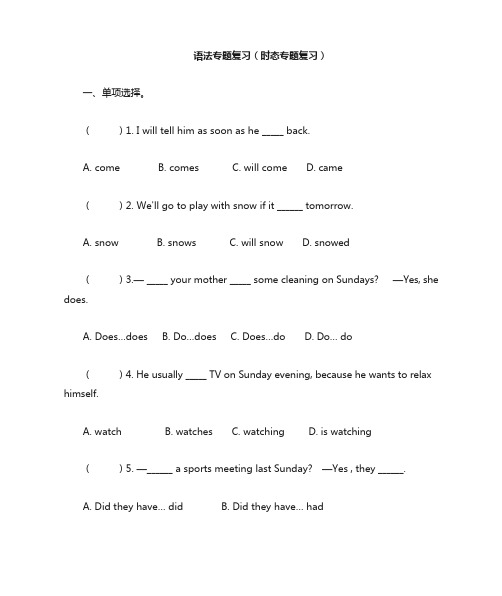
A. snow
B. snows
C. will snow D. snowed
( does.
)3.— _____ your mother _____ some cleaning on Sundays? —Yes, she
A. Does…does B. Do…does C. Does…do D. Do… do
( )11. You _____ me waiting for two hours. I _____ for you since five.
A. kept…waited
B. have kept…waited
C. kept…have waited D. have kept…have waited
( )12. —Where _____John _____?
6. We_________ (have) a good time in the Summer Palace last Sunday.
7. If it _________________ (not rain) tomorrow, we'll have a football match.
8. Don't forget _____________ (close) the window when you leave the room.
A. got to
B. reached C. arrive in D. reach
( )10. She ______ to school yesterday because of the strong wind and heavy rain.
A. goes B. went C. doesn’t go D. didn’t go
七年级英语 七年级动词时态总复习
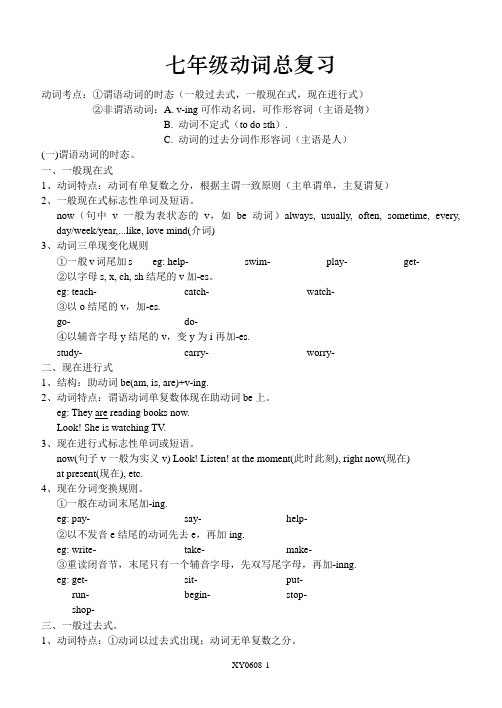
七年级动词总复习动词考点:①谓语动词的时态(一般过去式,一般现在式,现在进行式)②非谓语动词:A. v-ing可作动名词,可作形容词(主语是物)B. 动词不定式(to do sth).C. 动词的过去分词作形容词(主语是人)(一)谓语动词的时态。
一、一般现在式1、动词特点:动词有单复数之分,根据主谓一致原则(主单谓单,主复谓复)2、一般现在式标志性单词及短语。
now(句中v一般为表状态的v,如be动词)always, usually, often, sometime, every, day/week/year,...like, love mind(介词)3、动词三单现变化规则①一般v词尾加s eg: help-_________ swim-_________ play-_________ get-________②以字母s, x, ch, sh结尾的v加-es。
eg: teach-____________ catch-____________ watch-____________③以o结尾的v,加-es.go-____________ do-____________④以辅音字母y结尾的v,变y为i再加-es.study-____________ carry-____________ worry-____________二、现在进行式1、结构:助动词be(am, is, are)+v-ing.2、动词特点:谓语动词单复数体现在助动词be上。
eg: They are reading books now.Look! She is watching TV.3、现在进行式标志性单词或短语。
now(句子v一般为实义v) Look! Listen! at the moment(此时此刻), right now(现在)at present(现在), etc.4、现在分词变换规则。
①一般在动词末尾加-ing.eg: pay-____________ say-____________ help-____________②以不发音e结尾的动词先去e,再加ing.eg: write-____________ take-____________ make-____________③重读闭音节,末尾只有一个辅音字母,先双写尾字母,再加-inng.eg: get-____________ sit-____________ put-____________run-____________ begin-____________ stop-____________shop-____________三、一般过去式。
初中英语六种时态归纳复习(精编word)

初中英语六种时态归纳复习时态是英语学习中一个至关重要的内容一、一般现在时:概念:经常、反复发生的动作或行为及现在的某种状况。
时间状语:always, usually, often, sometimes, every week (day, year, month…), once a week, on Sundays, etc.基本结构:①be动词;②行为动词否定形式:①am/is/are+not;②此时态的谓语动词若为行为动词,则在其前加don't,如主语为第三人称单数,则用doesn't,同时还原行为动词。
一般疑问句:①把be动词放于句首;②用助动词do提问,如主语为第三人称单数,则用does,同时,还原行为动词。
二、一般过去时:概念:过去某个时间里发生的动作或状态;过去习惯性、经常性的动作、行为。
时间状语:ago, yesterday, the day before yesterday, last week(year, night, month…), in 1989, just now, at the age of 5, one day, long long ago, once upon a time, etc.基本结构:①be动词;②行为动词否定形式:①was/were+not;②在行为动词前加didn't,同时还原行为动词。
一般疑问句:①was或were放于句首;②用助动词do的过去式did 提问,同时还原行为动词。
三、一般将来时:概念:表示将要发生的动作或存在的状态及打算、计划或准备做某事。
时间状语:tomorrow, next da y(week, month, year…),soon, in a few minutes, by…,the day after tomorrow, etc.基本结构:①am/is/are/going to + do;②will/shall + do.否定形式:①was/were + not; ②在行为动词前加didn't,同时还原行为动词。
初中英语语法专项复习英语动词时态和语态讲解和练习题
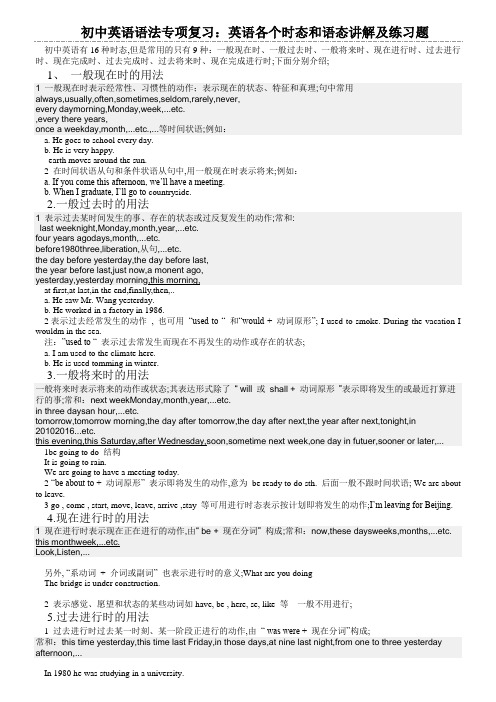
初中英语语法专项复习:英语各个时态和语态讲解及练习题初中英语有16种时态,但是常用的只有9种:一般现在时、一般过去时、一般将来时、现在进行时、过去进行时、现在完成时、过去完成时、过去将来时、现在完成进行时;下面分别介绍;1、一般现在时的用法1 一般现在时表示经常性、习惯性的动作;表示现在的状态、特征和真理;句中常用always,usually,often,sometimes,seldom,rarely,never,every daymorning,Monday,week,...etc.,every there years,once a weekday,month,...etc.,...等时间状语;例如:a. He goes to school every day.b. He is very happy.earth moves around the sun.2 在时间状语从句和条件状语从句中,用一般现在时表示将来;例如:a. If you come this afternoon, we’ll have a meeting.b. When I graduate, I’ll go to countryside.2.一般过去时的用法1 表示过去某时间发生的事、存在的状态或过反复发生的动作;常和:last weeknight,Monday,month,year,...etc.four years agodays,month,...etc.before1980three,liberation,从句,...etc.the day before yesterday,the day before last,the year before last,just now,a monent ago,yesterday,yesterday morning,this morning,at first,at last,in the end,finally,then,..a. He saw Mr. Wang yesterday.b. He worked in a factory in 1986.2表示过去经常发生的动作, 也可用“used to “ 和“would + 动词原形”; I used to smoke. During the vacation I wouldm in the sea.注:”used to “ 表示过去常发生而现在不再发生的动作或存在的状态;a. I am used to the climate here.b. He is used tomming in winter.3.一般将来时的用法一般将来时表示将来的动作或状态;其表达形式除了“ will 或shall + 动词原形”表示即将发生的或最近打算进行的事;常和:next weekMonday,month,year,...etc.in three daysan hour,...etc.tomorrow,tomorrow morning,the day after tomorrow,the day after next,the year after next,tonight,in 20102016...etc.this evening,this Saturday,after Wednesday,soon,sometime next week,one day in futuer,sooner or later,...1be going to do 结构It is going to rain.We are going to have a meeting today.2 “be about to + 动词原形” 表示即将发生的动作,意为be ready to do sth. 后面一般不跟时间状语; We are about to leave.3 go , come , start, move, leave, arrive ,stay 等可用进行时态表示按计划即将发生的动作;I’m leaving for Beijing.4.现在进行时的用法1 现在进行时表示现在正在进行的动作,由“ be + 现在分词” 构成;常和:now,these daysweeks,months,...etc. this monthweek,...etc.Look,Listen,...另外, “系动词+ 介词或副词” 也表示进行时的意义;What are you doingThe bridge is under construction.2 表示感觉、愿望和状态的某些动词如have, be , here, se, like 等一般不用进行;5.过去进行时的用法1 过去进行时过去某一时刻、某一阶段正进行的动作,由“ was were + 现在分词”构成;常和:this time yesterday,this time last Friday,in those days,at nine last night,from one to three yesterday afternoon,...In 1980 he was studying in a university.He was reading a novel when I came in.6.现在完成时的用法现在完成时由“have/has + 过去分词.其使用有两种情况:1 现在完成时所表示的动作在说话之前已完成,但对现在有影响;句中没有具体时间状语;常和:just,alreadly,yet,never,ever,now,before,this week,today,these days,once,twice,three times,...He has gone to Fuzhou.He has been to Fuzhou.2 现在完成时所表示的动作开始于过去,持续到现在,也许还会持续下去常用for 和since表示一段时间的状语或since then1949,last Monday,two o'clock,从句...,etc.,ever since then,for three daysa long time,two hours,...etc.so far , now, today, this wek month, year 等表示包括现在内的状语;He has studied English for 5 years.He has studied English since 1985.Now I have finished the work..注意:表示短暂时间动作的词如come, go , die, marry, buy 等的完成时不能与for, since 等表示一般时间的词连用;正确:I have bought the book already.错误:I have bought the book for two years.改:I have had the bookl for two years.7.过去完成时的用法1 过去完成时由“had + 过去分词”构成;过去完成时的动作表示过去某一时刻或某一时刻或某一动作之前完成的动作或状态;句中常用by then1977,yesterday,eight last night,the time we got there,...etc.by the end of last termweek,year,month,...etc..by, before, until, when 等词引导的时间状语;By the end of last year we had built five new houses.I had learnt 5000 words before I entered the university.2过去完成时的动词还可表示过去某一时刻之前发生的动作或状态持续到过去某个时间或持续下去;Before he slept, he had worked for 12 hours.8.过去将来时的用法过去将来时表示从过去的某个时间看来将要发生的动作或存在的状态;过去将来时由“should 或would + 动词原形” 构成;第一人称用should, 其他人称用would. ;常和:They were sure that they would succeed.二动词语态1.当句子的主语是动作的执行者时, 谓语的形式叫主动语态;句子的主语是动作承受者时,谓语的形式叫被动作语态;被动语态由助动词be + 过去分词构成,时态通过be 表现出来;1 一般现在时:You are required to do this.2 一般过去时:The story was told by her.3 一般将来时:The problem will be discussed tomorrow.4 现在进行时:The road is being widened.5 过去进行时:The new tool was being made.6 现在完成时:The novel has been read.7 过去完成时:He said that the work had been finished.8 过去将来时:He said that the trees would be planted soon.2. 一些特殊的被动结构1 带情态动词的被动结构:The problem must be solved soon.2 带不定式的被动结构:The room is going to be painted.The homework needs to be done with care.3 短语动词的被动:a.不及物动词+介词:若这类短语动词是及物性的,则可用于被动语态中,如:laugh at, look after, talk about, think of 等;若这类短语动词是不及物性的则不可用于被动语态中,如:book up, look down. 等b.及物动词+副词:bring about, carry out, find out, make out, put away, put off, take up, turn down, turn out, wipe out 等c. 动词+副词+介词:do away with, face up to, give into ,look down upon, make up with等d. 动词+名词+介词:catch sight of, keep on eye on, make a fool of , pay attention to , put an end to , set fire/light to , take notice of 等4 带复合宾语的动词在改为被动语态时,一般把主动结构中的宾语改为主语,宾语补足语保留在谓语后面;We always keep the classroom clean.比较:The classroom is always kept clean.5主动形式表示被动意义的词;常见的有:a.主动形式,这时动名词同句中的主语有动宾关系;The children need looking after.The windows wants /requires repairing.This point deserves mentioning.练习题1. It is a fine day. The sun __________shine brightly.2. They ___________visit the Science Museum next Sunday.3. Mr Brown________live in Beijing since he came to China.4. Mr Wang ________teach us English two years ago.5. The Smiths _______________ watch TV at this time last night.6. We __________learn about ten English songs by the end of last term.7. Father said that he ____________buy a new bike for me the next Friday.8. Bill isn¡¯t here. He ___________chat with his friends in the classroom.9. The teacher said that the moon __________go round the earth.10. The Young Pioneers will go to the zoo if it ____________not rain this Sunday.11. Listen They __________talk about the new film.12. Jim asked us what ___________happen in China in 1976.13. My mobile phone ___________steal on a bus last week.14. The host ____________interview the little boy just now.15. The Greens __________watch TV now.16. He said that he _____________ring me up when he got there.17. We ____________learn English for about three years.18. My brother_____________join the League in 1997.19. The farmers __________pick apples when I saw them.20. The red skirt __________cost the girl forty yuan.21. The film ____________begin when I got to the cinema.22. The girl told me that she wanted to be an English teacher when she _____grow up.23. My sister is a student and she _____________study at a middle school nearby.24. Mr Green __________travel to several places in South China since he came here.25. You _________catch the early bus if you get up early.26. _______you been________wear glasses all the time27. I’ll go home as soon as I _______finish my homework.29. Most science books are ______write in English.30. I ____________stay there for two months last year.31. Tell Lily to call me as soon as she _______.A. will arriveB. gets thereC. has goneD. reach here32. ----Hi, Kate. You look tired. What’s the matter ----I ______ well last night.A. didn’t sleepB. don’t sleepC. haven’t sleptD. won’t sleep33. ----Excuse me, look at the sign over there, please. Could you stop smoking----Sorry, I ____ that.A. didn’t seeB. don’t seeC. won’t seeD. can’t see34. ----Well, I found this. I think it must be yours. ----My watch Thank you. Where _____itA. do you findB. had you foundC. were you findingD. did you find35. ----Don you know when Dr White ____ for dinner this evening----No, but I think he ____ when he is free.A. will come; comesB. will come; will comeC. comes; comesD. comes; will come36. Look at those black clouds. It _____ rain. Let’s hurry. A. maybe B. would C. has D. is going to37. ----Jimmy is leaving for a holiday. ----Really Where ____ he ____A. has; goneB. will; goC. did; goD. does; go38. ----Shall we go shopping now ---Sorry, I can't. I ____ my shirts.A. washB. washesC. washedD. am washing39. ----I called you yesterday evening, but there was no answer.----Oh, I am sorry. I ___ dinner at my friend's home.A. haveB. hadC. was havingD. have had40. The Oriental Pearl TV Tower ____ thousands of visitors since 1995.A. attractedB. attractsC. has attractedD. will attract46. ----Why didn't you go to the cinema yesterday -----Because I ____ the film before.A. had seenB. have seenC. have watchedD. has watched47. I don't think John saw me. He ____ a book at that moment.A. just readB. has just readC. was just readingD. had just read48. Mr Smith ____ a book about China last year but I don't know whether he has finished it.A. has writtenB. wroteC. had writtenD. was writing49. Mr White ____ the newspaper while his daughter ____TV.A. has read; was watchingB. was reading; watchedC. was reading; was watchingD. reading; watched50. ---- I ____ you at the meeting. Why ----I was ill. A. saw B. have seen C. not see D. didn't see51. The 29th Olympic Games ____ in Beijing in 2008. A. hold B. will hold C. will be held D. held52. Hurry up The play ____ for ten minutes. A. has been on B. has begun C. had begun D. began53. ----May I speak to Mr Smith ----Sorry, he ____ Australia. But he ____ in two days.A. has been to; will come backB. has gone to; will be backC. has been in; would come backD. is leaving for; doesn't come back54. I can't go to the theater tonight because I ____ my ticket.A. have lostB. had lostC. will loseD. was losing55. ----What a nice bike How long ____ you ____ it ----Just two weeks.A. have; boughtB. did; buyC. have; hadD. are; having56. ----I'm sorry to have kept you waiting. ----Oh, not at all. I ____ here only for a few minutes.A. have comeB. had beenC. wasD. have been57. ----____ my dictionary anywhere ---- Yes. I saw it on your desk a moment ago.A. Did you seeB. If you seeC. Had you seenD. Would you see58. We were all surprised when he mad it clear that he ____ office soon.A. leavesB. would leaveC. will leaveD. had left答案:I. 1. shines/ is shining 2. are going to/ will visit 3. has lived 4. taught5. were watching6. had learned7. would buy8. is chatting9. goes 10.doesn't rain 11. are talking 12. happened 13. was stolen 14. interviewed15. are watching16. would ring 17. have learned 18. joined 19. were picking 20. cost21. had begun 22. grew 23. studies 24. has traveled 25. will catch26. Have; wearing 27. finish 28. haven't heard 29. written 30. stayedII. 31--35 BAADB 36--40 DBDCC 41--45 ACBAC 46--50 ACDCD51--55 CABAC 56--60 DABDA 61--65 BDBAB 66-70 BDABC 71--75 BCADD。
初一英语时态总结集中复习(上课内容)
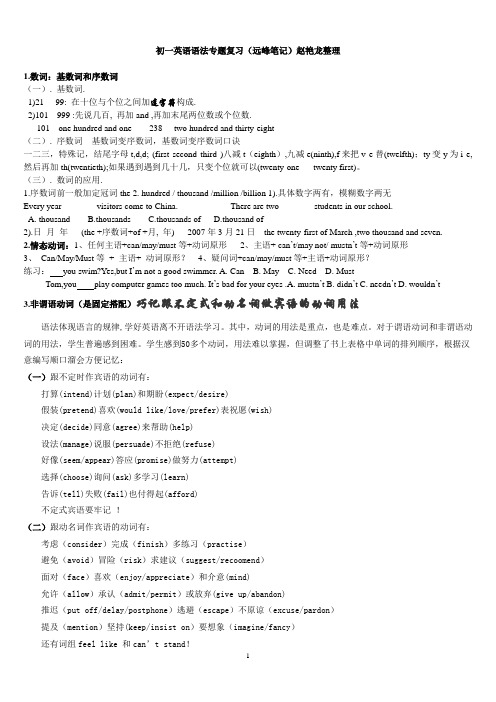
初一英语语法专题复习(远峰笔记)赵艳龙整理1.数词:基数词和序数词(一). 基数词.1)21----99: 在十位与个位之间加连字符构成.2)101---999 :先说几百, 再加and ,再加末尾两位数或个位数.101---one hundred and one 238----two hundred and thirty-eight(二). 序数词基数词变序数词,基数词变序数词口诀一二三,特殊记,结尾字母t,d,d; (first second third )八减t(eighth),九减e(ninth),f来把v e替(twelfth);ty变y为i e,然后再加th(twentieth);如果遇到遇到几十几,只变个位就可以(twenty-one---- twenty first)。
(三). 数词的应用.1.序数词前一般加定冠词the2. hundred / thousand /million /billion 1).具体数字两有,模糊数字两无Every year _______ visitors come to China. There are two _______ students in our school.A. thousandB.thousandsC.thousands ofD.thousand of2).日月年(the +序数词+of +月, 年) 2007年3月21日---the twenty-first of March ,two thousand and seven.2.情态动词:1、任何主语+can/may/must等+动词原形2、主语+ can’t/may not/ mustn’t等+动词原形3、Can/May/Must等+ 主语+ 动词原形?4、疑问词+can/may/must等+主语+动词原形?练习:you swim?Yes,but I’m not a good swimmer. A. Can B. May C. Need D. MustTom,you play computer games too much. It’s bad for your eyes .A. mustn’t B. didn’t C. needn’t D. wouldn’t3.非谓语动词(是固定搭配)巧记跟不定式和动名词做宾语的动词用法语法体现语言的规律,学好英语离不开语法学习。
(完整版)初一英语各种时态复习及练习题
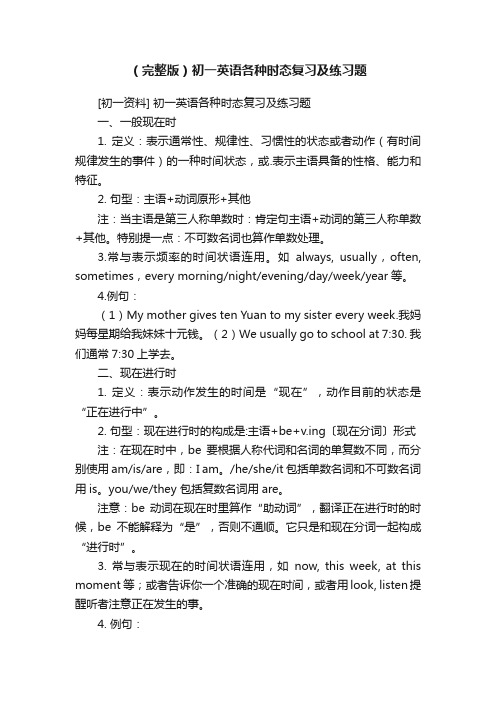
(完整版)初一英语各种时态复习及练习题[初一资料] 初一英语各种时态复习及练习题一、一般现在时1. 定义:表示通常性、规律性、习惯性的状态或者动作(有时间规律发生的事件)的一种时间状态,或.表示主语具备的性格、能力和特征。
2. 句型:主语+动词原形+其他注:当主语是第三人称单数时:肯定句主语+动词的第三人称单数+其他。
特别提一点:不可数名词也算作单数处理。
3.常与表示频率的时间状语连用。
如always, usually,often, sometimes,every morning/night/evening/day/week/year等。
4.例句:(1)My mother gives ten Yuan to my sister every week.我妈妈每星期给我妹妹十元钱。
(2)We usually go to school at 7:30. 我们通常7:30上学去。
二、现在进行时1. 定义:表示动作发生的时间是“现在”,动作目前的状态是“正在进行中”。
2. 句型:现在进行时的构成是:主语+be+v.ing〔现在分词〕形式注:在现在时中,be 要根据人称代词和名词的单复数不同,而分别使用am/is/are,即:I am。
/he/she/it 包括单数名词和不可数名词用is。
you/we/they 包括复数名词用are。
注意:be 动词在现在时里算作“助动词”,翻译正在进行时的时候,be不能解释为“是”,否则不通顺。
它只是和现在分词一起构成“进行时”。
3. 常与表示现在的时间状语连用,如now, this week, at this moment 等;或者告诉你一个准确的现在时间,或者用look, listen提醒听者注意正在发生的事。
4. 例句:(1)They are playing basketball now.现在他们正在打篮球。
(2)Listen! She is singing a song.听,她正在唱歌。
七年级英语时态总结

七年级英语时态总结一、一般现在时。
1. 概念。
- 表示经常或习惯性的动作或存在的状态。
例如:I often go to school by bike.(我经常骑自行车去上学。
)He is a student.(他是一名学生。
)2. 构成。
- be动词:主语为第一人称单数(I)时用am;主语为第三人称单数(he/she/it 等)时用is;主语为复数(we/you/they等)或第二人称单数(you)时用are。
例如:I am a girl. He is my brother. They are my friends.- 实义动词:- 当主语为第三人称单数时,动词要加 -s或 -es。
例如:He likes reading books.(like变成likes)- 当主语为其他人称时,动词用原形。
例如:We play football on Sundays.3. 时间状语。
- 常与often(经常), usually(通常), sometimes(有时), always(总是), every day/week/month/year(每天/周/月/年)等连用。
例如:She usually gets up at six o'clock.二、现在进行时。
1. 概念。
- 表示现在正在进行的动作或存在的状态。
例如:Look! They are playing basketball.(看!他们正在打篮球。
)2. 构成。
- be动词(am/is/are)+动词的 -ing形式。
例如:I am reading a book. Heis watching TV. They are having lunch.3. 动词 -ing形式的构成规则。
- 一般在动词原形末尾加 -ing。
如:go - going, play - playing。
- 以不发音的字母e结尾的动词,先去掉e,再加 -ing。
如:write - writing, have - having。
初中英语动词时态总复习(超级精华版)

2. 过去将来时的用法 : 1)表示从过去某时看将要发生的动作或存在的状态。常用于主句是一般过去时的宾语从句中。 例如:He said that he would finish his work before 9 o’clock. 他说他会在九点之前完成工作。 2)“was/were going to+动词原形”所表示的过去将来时,表示过去曾经打算或将要做某事。 例如:She said she was going to buy a car. 她说她打算买一辆小汽车。
01
02
1.改为一般疑问句并回答。
Yes, I will./No, I won't. I won't do my homework tonight.
I will do my homework tonight. Will you do your homework tonight?
2.改为否定句。
句型转换
表示在过去,经常或反复发生的动作。常与often,always等表示频度的副词连用。
01
例如:
02
When I was a child, I often played football in the street.
03
我是个孩子的时候,常在马路上踢足球。
04
例如:Did you see him today?
1.改为一般疑问句并回答。
01
句型转换
1.改为一般疑问句并回答。
2.改为否定句。
Jim does his homework every day. Does Jim do his homework every day?
Yes, he does./No, he doesn't. Jim doesn't do his homework every day.
七年级英语时态专项训练50题
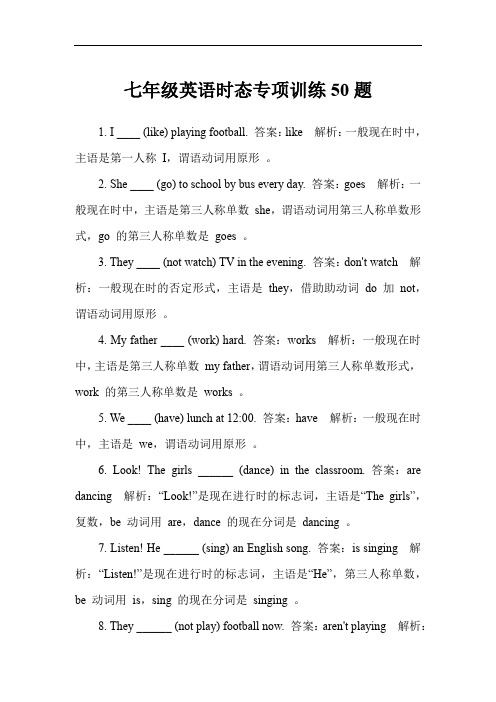
七年级英语时态专项训练50题1. I ____ (like) playing football. 答案:like 解析:一般现在时中,主语是第一人称I,谓语动词用原形。
2. She ____ (go) to school by bus every day. 答案:goes 解析:一般现在时中,主语是第三人称单数she,谓语动词用第三人称单数形式,go 的第三人称单数是goes 。
3. They ____ (not watch) TV in the evening. 答案:don't watch 解析:一般现在时的否定形式,主语是they,借助助动词do 加not,谓语动词用原形。
4. My father ____ (work) hard. 答案:works 解析:一般现在时中,主语是第三人称单数my father,谓语动词用第三人称单数形式,work 的第三人称单数是works 。
5. We ____ (have) lunch at 12:00. 答案:have 解析:一般现在时中,主语是we,谓语动词用原形。
6. Look! The girls ______ (dance) in the classroom. 答案:are dancing 解析:“Look!”是现在进行时的标志词,主语是“The girls”,复数,be 动词用are,dance 的现在分词是dancing 。
7. Listen! He ______ (sing) an English song. 答案:is singing 解析:“Listen!”是现在进行时的标志词,主语是“He”,第三人称单数,be 动词用is,sing 的现在分词是singing 。
8. They ______ (not play) football now. 答案:aren't playing 解析:now 是现在进行时的标志词,主语是“They”,复数,be 动词用are,否定形式是aren't,play 的现在分词是playing 。
初中英语九种时态归纳复习
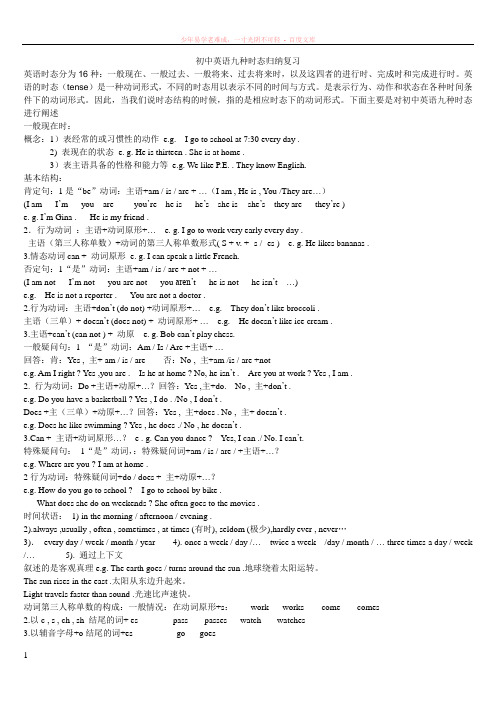
初中英语九种时态归纳复习英语时态分为16种:一般现在、一般过去、一般将来、过去将来时,以及这四者的进行时、完成时和完成进行时。
英语的时态(tense)是一种动词形式,不同的时态用以表示不同的时间与方式。
是表示行为、动作和状态在各种时间条件下的动词形式。
因此,当我们说时态结构的时候,指的是相应时态下的动词形式。
下面主要是对初中英语九种时态进行阐述一般现在时:概念:1)表经常的或习惯性的动作 e.g. I go to school at 7:30 every day .2) 表现在的状态e. g. He is thirteen . She is at home .3)表主语具备的性格和能力等e.g. We like P.E. . They know English.基本结构:肯定句:1是“be”动词:主语+am / is / are + …(I am , He is , You /They are…)(I am --- I’m you are---- you’re he is --- he’s she is -- she’s they are --- they’re )e. g. I’m Gina . He is my friend .2.行为动词:主语+动词原形+… e. g. I go to work very early every day .主语(第三人称单数)+动词的第三人称单数形式( S + v. + -s / -es ) e. g. He likes bananas .3.情态动词can + 动词原形e. g. I can speak a little French.否定句:1“是”动词:主语+am / is / are + not + …(I am not --- I’m not you are not --- you aren’t he is not --- he isn’t …)e.g. He is not a reporter . You are not a doctor .2.行为动词:主语+don’t (do not) +动词原形+… e.g. They don’t like broccoli .主语(三单)+ doesn’t (does not) + 动词原形+ … e.g. He doesn’t like ice cream .3.主语+can’t (can not ) + 动原 e. g. Bob can’t play chess.一般疑问句:1 “是”动词:Am / Is / Are +主语+ …回答:肯:Yes , 主+ am / is / are 否:No , 主+am /is / are +note.g. Am I right ? Yes ,you are . Is he at home ? No, he isn’t . Are you at work ? Yes , I am .2. 行为动词:Do +主语+动原+…?回答:Yes ,主+do. No , 主+don’t .e.g. Do you have a basketball ? Yes , I do . /No , I don’t .Does +主(三单)+动原+…?回答:Yes , 主+does . No , 主+ doesn’t .e.g. Does he like swimming ? Yes , he does ./ No , he doesn’t .3.Can + 主语+动词原形…?e . g. Can you dance ? Yes, I can ./ No. I can’t.特殊疑问句:1“是”动词,:特殊疑问词+am / is / are / +主语+…?e.g. Where are you ? I am at home .2行为动词:特殊疑问词+do / does + 主+动原+…?e.g. How do you go to school ? I go to school by bike .What does she do on weekends ? She often goes to the movies .时间状语:1) in the morning / afternoon / evening .2).always ,usually , often , sometimes , at times (有时), seldom (极少),hardly ever , never…3).every day / week / month / year 4). once a week / day /…twice a week /day / month / … three times a day / week /…5). 通过上下文叙述的是客观真理e.g. The earth goes / turns around the sun .地球绕着太阳运转。
七年级英语下册时态复习资料及复习题

七年级英语下册时态复习资料及复习题语法时态是英语学习中的重点难点知识,也是我们必须掌握的知识点,下面是小编给大家带来的七年级英语下册时态复习资料及复习题,希望能够帮助到大家!. 重难点讲解:1. 一般现在时:用法:表示经常发生的事情或经常存在的状态。
常与表示频度的时间状语连用。
It often rains in summer. 表示预定的行为/事情;The class begins at 9 a.m.. 描述客观真理/存在;The sun is bigger than the moon. 表内心活动、感情等;I think that’s a good idea. 用于表将来的从句。
If it is fine tomorrow, we will go. 注意: (1)第三人称单数。
(2)频度副词的位置及使用。
always, usually, often, sometimes, seldom, never I’ll never forget the day when I met him.2. 现在进行时:表达现在正在发生的事情或正在进行的行为 They are having a meeting now. 表示现阶段正在进行的事情。
He is writing a book these months. 注意: (1)表示来或去的动词:如 go, come, leave, arrive 等的现在进行时表示将要发生的动作。
Tomorrow I’m leaving for Shanghai.(2)时间状语:now, 具体某一时间点3. 一般过去时:表达过去发生的事情、行为或存在状态 It was 11 o’clock when I went to bed last night. 表达过去经常发生的事情。
He got up very early when he was in middle school. 注意:动词的过去式时间状语:yesterday, last week, an hour ago, the other day, in 1982,just now 等。
初中英语八种时态归纳复习
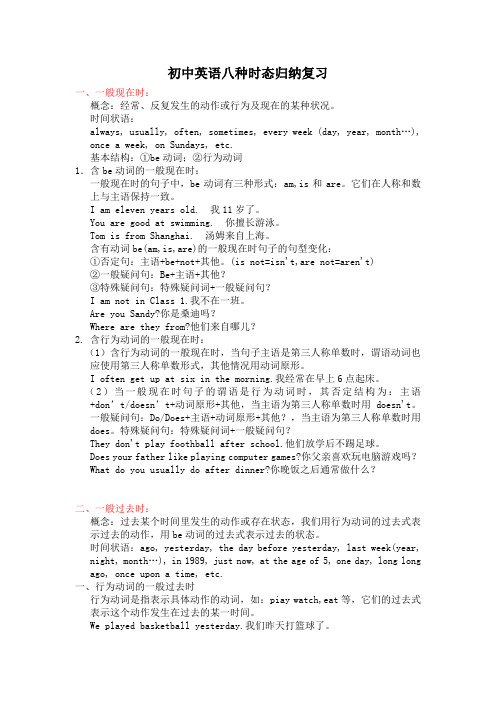
初中英语八种时态归纳复习一、一般现在时:概念:经常、反复发生的动作或行为及现在的某种状况。
时间状语:always, usually, often, sometimes, every week (day, year, month…), once a week, on Sundays, etc.基本结构:①be动词;②行为动词1.含be动词的一般现在时:一般现在时的句子中,be动词有三种形式:am,is和are。
它们在人称和数上与主语保持一致。
I am eleven years old. 我11岁了。
You are good at swimming. 你擅长游泳。
Tom is from Shanghai. 汤姆来自上海。
含有动词be(am,is,are)的一般现在时句子的句型变化:①否定句:主语+be+not+其他。
(is not=isn't,are not=aren't)②一般疑问句:Be+主语+其他?③特殊疑问句:特殊疑问词+一般疑问句?I am not in Class 1.我不在一班。
Are you Sandy?你是桑迪吗?Where are they from?他们来自哪儿?2. 含行为动词的一般现在时:(1)含行为动词的一般现在时,当句子主语是第三人称单数时,谓语动词也应使用第三人称单数形式,其他情况用动词原形。
I often get up at six in the morning.我经常在早上6点起床。
(2)当一般现在时句子的谓语是行为动词时,其否定结构为:主语+d on’t/doesn’t+动词原形+其他,当主语为第三人称单数时用doesn't。
一般疑问句:Do/Does+主语+动词原形+其他?,当主语为第三人称单数时用does。
特殊疑问句:特殊疑问词+一般疑问句?They don't play foothball after school.他们放学后不踢足球。
- 1、下载文档前请自行甄别文档内容的完整性,平台不提供额外的编辑、内容补充、找答案等附加服务。
- 2、"仅部分预览"的文档,不可在线预览部分如存在完整性等问题,可反馈申请退款(可完整预览的文档不适用该条件!)。
- 3、如文档侵犯您的权益,请联系客服反馈,我们会尽快为您处理(人工客服工作时间:9:00-18:30)。
初一英语时态专题复习一、一般现在时:(1、现在的状态。
2、经常或习惯性动作。
3、主语所具备的性格和能力。
4、真理。
)1、标志:often(经常),usually(通常),sometimes(有时),always(总是),never(从不),on Sundays(在星期天), every day/month/year(每一天/月/年)2、结构:(1)主语+连系动词be(am/is/are)+名词/形容词/数词/介词短语/副词等做表语表状态(包括There be +n.)练习:1.I______(be) a student. My name_____(be) Tom.2. Where _____(be) my shoes? They___(be) here.3.Who ____(be) the girl with long straight hair? I think she ___(be) Kate.4. You and I ___(not be) in Class Six.5.___(be) there a supermarket on the Fifth Avenue? Yes, there_____(be).6. ____ her parent tall? No, he____.(2)主语(非第三人称单数)+行为动词原形+其他(用助动词do 帮助构成否定句、一般疑问句和特殊疑问)(3)主语(第三人称单数)+行为动词的第三人称单数+其他(用助动词does 帮助构成否定句、一般疑问句和特殊疑问句)行为动词第三人称单数加-s的形式1.- s 2. 辅音+y: study-studies 3.以s,x,ch,sh结尾watch-watches teach-teaches4特殊have-has do-does go-goes.1)His parents _______(watch) TV every night. 肯定句1) My brother _________(do) homework every day.2)His parents _________(not watch) every night.否定句2)My brother________(not do)homework every day.3)_____his parents_____(watch) TV every night?一般疑3)______ your brother _____ homework every day?Yes, they _______. No, they _______. Yes, he______. No, he _________.4)When___ his parents _____(watch) TV? 特疑4)When _____ your brother ____(do) homework?They watch TV every night. He does homework every day.二.现在进行时:表示说话瞬间或现阶段正在进行的动作。
1、标志: now(现在)listen(看)look(听)2、结构:主语+助动词be(am/is/are)+行为动词的现在分词(doing)现在分词的构成:1.-ing: eat-eating 2.辅音字母+e: take-taking3. sit, put, begin, run, swim, stop, get, shop,(双写最后一个辅音字母,再加ing.)练习:1. Jim __________________(take) photos in the park now. 2. Jim_________(not take) in the park now. 3. _______________Jim____________(take) photos in the park now? Yes, he _____. No, he _______.4. Where _________Jim ____________ photos now? In the park.三、情态动词:1、任何主语+can/may/must+动词原形2、主语+ can’t/may not/ mustn’t+动词原形3、Can/May/Must + 主语+ 动词原形?4、疑问词+can/may/must+主语+动词原形?四、非谓语动词(是固定搭配)1. like+ to do不定式/doing动名词2.want to do sth.3. love to do4. would like to do sth.5. enjoy doing sth.6. thanks for doing7. stop doing sth8. let sb. do sth.She wants _____(have) a party. Does he like _______(swim)?Thanks for _______(enjoy) CCTV show. She never stops ____(talk).五.祈使句:Go straight and turn left/ right.Go through Fifth Avenue.Take a taxi(Take a bus,Take a walk……)六.综合练习:1.Mr Green _____(be) a worker. Now he ____(work) in the field. 2.Listen! Who_______(sing)?3.What time ____ your brother usually _____(do) his homework?4.You can_______(come) here by bus.5. Who ____(have) a ruler?6.Are they_____(clean) the room?7.-____ you____(eat) dinner? – Yes, we are.8.Jack ____(have) a soccer ball, but he ____(not have) a basketball. 9._______Jim _______(like)______(run)?10.They _____(be) from Canada. They______(not speak) Chinese. 11. He wants _________________(be) tall.1.我们正在吃晚餐。
2、我们每天6点起床。
We __________________________. We __________________ at six every day.3.你们在聊天吗?是的。
4、他们常常聊天吗?不是。
_______ they _______? Yes, they _____. ______ they often ______ ? No, they ________.5、他在做什么?他在做作业。
6、他晚上常干什么?他常做作业。
What ____he ___? He_______. What ___he usually ___ in the evening? He usually______.答案:1.are having dinner 2. get up 3. Are , talking , are 4. Do , talk, don’t5. is doing, is doing homework6. does, do, does , homework七.人称代词:我你他她它我们你们他/她/它们主格:I you he she it we you they宾格:me you him her it us you them形容词性物主代词:我的你的他的她的它的我们的你们的他/她/它们的my your his her its our your their练习:1.________(我) am a worker. _________(你) are a doctor. ______(她) is a teacher.2.This is (他的)shirt.3. This is __________(我的)pen.4._________(他们的) trousers are there.5. I like this picture. Please give ________(它) to ________(我).6. People get ________(他们的) money from _________(我).7._____(他们) are new students. _____(他们的) names are Lucy and Lily.8. These are _____(我们的) shoes. Can ____(我们) wear ______(它们).9.Thank _______ for _______(你的) help.10. _______(他) loves _______(她), and _______(她) loves _______(他),too._______(我) love _________(你), and ________(你) love _______(我),too.八,There be句型句型转换1)There is a bank on the street. 2) There are some cars in front of the park.否定句:There _______a bank on the street. 否定句:There ______ _______cars in front of the bank. 一般疑问句:_______ ______ a bank on the street? 一般疑问句:____ ______ ______cars in front of the bank? 就划线部分提问:________ on the street? 就划线部分提问:_____ _____ in front of the bank?There’s a bank on the street. There are some cars in front of the bank.同上:____ ______ ______are there on the street? 同上:____ ____ ____ are there in front of the bankThere’s only one. There’re some.2)将下列句子改为否定句、一般疑问句,并就划线部分提问。
